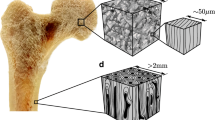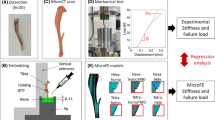Abstract
Standard methods for predicting bone’s mechanical response from quantitative computer tomography (qCT) scans are mainly based on classical h-version finite element methods (FEMs). Due to the low-order polynomial approximation, the need for segmentation and the simplified approach to assign a constant material property to each element in h-FE models, these often compromise the accuracy and efficiency of h-FE solutions. Herein, a non-standard method, the finite cell method (FCM), is proposed for predicting the mechanical response of the human femur. The FCM is free of the above limitations associated with h-FEMs and is orders of magnitude more efficient, allowing its use in the setting of computational steering. This non-standard method applies a fictitious domain approach to simplify the modeling of a complex bone geometry obtained directly from a qCT scan and takes into consideration easily the heterogeneous material distribution of the various bone regions of the femur. The fundamental principles and properties of the FCM are briefly described in relation to bone analysis, providing a theoretical basis for the comparison with the p-FEM as a reference analysis and simulation method of high quality. Both p-FEM and FCM results are validated by comparison with an in vitro experiment on a fresh-frozen femur.
Similar content being viewed by others
References
Babuška I (1973) The finite element method with Lagrange multipliers. Numer Math 20: 179–192
Babuška I (1973) The finite element method with penalty. Math Comput 27(122): 221–228
Baca V, Horak Z, Mikulenka P, Dzupa V (2008) Comparison of an inhomogeneous orthotropic and isotropic material models used for fe analyses. Med Eng Phys 30: 924–930
Bathe K-J (2002) Finite Elemente Methoden. Springer, Berlin
Düster A, Parvizian J, Yang Z, Rank E (2008) The finite cell method for three-dimensional problems of solid mechanics. Comput Methods Appl Mech Eng 197: 3768–3782
Fernández-Méndez S, Huerta A (2004) Imposing essential boundary conditions in mesh-free methods. Comput Methods Appl Mech Eng 193: 1257–1275
Galishnikova V, Dunaiski P, Pahl P (2009) Geometrically nonlinear analysis. Sun Press–Sun Media, Stellenbosch
Griebel M, Schweitzer M (2002) A particle-partition of unity method. Part V: boundary conditions. Springer, Berlin
Hansbo P (2005) Nitsche’s method for interface problems in computational mechanics. GAMM Mitteilungen 28(2): 183–206
Keyak J, Falkinstein Y (2003) Comparison of in situ and in vitro CT-scan-based finite element model predictions of proximal femoral fracture load. J Med Eng Phys 25: 781–787
Keyak J, Fourkas M, Meagher J, Skinner H (1993) Validation of an automated method of three-dimensional finite element modelling of bone. J Biomed Eng 15(6): 505–509
Les C, Keyak J, Sover S, Taylor K, Kaneps A (1994) Estimation of material properties in the equine metacarpus with use of quantitative computed tomography. J Orthop Res 12: 822–833
Nitsche J (1970) Über ein Variationsprinzip zur Lösung von Dirichlet-Problemen bei Verwendung von TeilrSumen, die keinen Randbedingungen unterworfen sind. Abhandlung aus dem Mathematischen Seminar der UniversitSt Hamburg 36: 9–15
Parvizian J, Düster A, Rank E (2007) Finite cell method—h- and p-extension for embedded domain problems in solid mechanics. Comput Mech 41: 121–133
Peng L, Bai J, Zeng Z, Zhou Y (2006) Comparison of isotropic and orthotropic material property assignments on femoral finite element models under two loading conditions. Med Eng Phys 28: 227–233
Ruess M, Mundani R, Burgkart R, Duester A, Rank E, Westermann R (2008) Computational steering for orthopaedics. In: BIO materialien, vol 9
Ruess M, Rank E (2010) From voxel-FEM to p-FEM-based analyses in bone mechanics. In: Proceedings of the 2010 EMI conference
Schillinger D, Kollmannsberger S, Mundani R, Rank E (2010) The finite cell method for nonlinear problems of solid mechanics. In: Proceedings of the world conference on computational mechanics. Sidney
Schileo E, Dall’Ara E, Taddei F, Malandrino A, Schotkamp T, Viceconti M (2008) An accurate estimation of bone density improves the accuracy of subject-specific finite element models. J Biomech 41: 2483–2491
Schileo E, Taddei F, Malandrino A, Cristofolini L, Viceconti M (2007) Subject-specific finite element model scan accurately predict strain levels in long bones. J Biomech 40: 2982–2989
Szabó B, Babuška I (1991) Finite element analysis. Wiley, New York
Szabó B, Düster A, Rank E (2004) The p-version of the finite element method. In: Encyclopedia of computational mechanics, vol 1(5). Wiley, New York, pp 119–139
Taddei F, Cristofolini L, Martelli S, Gill H, Viceconti M (2006) Subject-specific finite element models of long bones: an in vitro evaluation of the overall accuracy. J Biomech 39: 2457–2467
Taddei F, Pani M, Zovatto L, Tonti E, Viceconti M (2008) A new meshless approach for subject-specific strain prediction in long bones: evaluation of accuracy. Clin Biomech 23(9): 1192–1199
Trabelsi N, Yosibash Z, Milgrom C (2009) Validation of subject-specific automated p-FE analysis of the proximal femur. J Biomech 42: 234–241
Viceconti M, Davinelli M, Taddei F, Cappello A (2003) Automatic generation of accurate subject-specific bone finite element models to be used in clinical studies. J Biomech 37: 1597–1605
Yang Z, Dick C, Düster A, Ruess M, Westermann R, Rank E (2010) Finite cell method with fast integration—an efficient and accurate analysis method for CT/MRI derived models. In: Proceedings of the ECCM 2010
Yosibash Z, Padan R, Joscowicz L, Milgrom C (2007) A CT-based high-order finite element analysis of the human proximal femur compared to in-vitro experiments. ASME J Biomech Eng 129(3): 297–309
Yosibash Z, Trabelsi N, Milgrom C (2007) Reliable simulations of the human proximal femur by high-order finite element analysis validated by experimental observations. J Biomech 40: 3688–3699
Author information
Authors and Affiliations
Corresponding author
Additional information
Zohar Yosibash: Research performed while on Sabbatical leave at the Chair for Computation in Engineering at the Technische Universität München.
Rights and permissions
About this article
Cite this article
Ruess, M., Tal, D., Trabelsi, N. et al. The finite cell method for bone simulations: verification and validation. Biomech Model Mechanobiol 11, 425–437 (2012). https://doi.org/10.1007/s10237-011-0322-2
Received:
Accepted:
Published:
Issue Date:
DOI: https://doi.org/10.1007/s10237-011-0322-2




